3 STAKEHOLDER EVENT SUMMARIES
3.1 COP28 side event
On 4 December 2023, the side event “Voluntary Carbon Markets: Latest Developments in Best Practices" was held at the Nordic Pavilion during the COP28 climate conference in Dubai. The event included an introduction to best practices in the voluntary carbon market (VCM) and a panel discussion among public and private sector experts on the evolving role of VCM in the context of the Paris Agreement. Besides the full room of on-site audience, the event had remote viewers via live-stream. The recording of the event is available on the Nordic Dialogue website. The event was organised by Perspectives Climate Research.

From left to right: Juliana Kessler, Owen Hewlett, Malin Ahlberg and Teppo Säkkinen.
Photo by Andreas Omvik
Photo by Andreas Omvik
Setting the scene
To set the scene, moderator Juliana Kessler (Perspectives Climate Research) provided an overview of the Nordic Code of Best Practice for the Voluntary Use of Carbon Credits and other key initiatives on VCM integrity and introduced key concepts such as the action and ambition gaps, and offsetting and contribution claims.
Before the panel discussion began, the audience participated in an online poll to share their views on the role of the VCM, specifically whether it should support countries in meeting national targets, enhance global ambition beyond national targets, or both. A majority (71%) favoured a dual role for the VCM, while 19% believed it should focus solely on raising global ambition, and 10% felt it should focus solely on aiding national targets. Most respondents considered the best practices for the VCM to be "somewhat" clear.
Juliana introduced the panel, featuring Owen Hewlett from The Gold Standard Foundation, Malin Ahlberg from the German Ministry of the Environment, and Teppo Säkkinen from the Finnish Chamber of Commerce. Additionally, David Radermacher from the international energy company E.ON shared private sector perspectives from the audience.
What role for the VCM?
All panellists agreed that the VCM could and should play a dual role in supporting national targets and raising global ambition beyond them. Owen Hewlett emphasised the need for clearer guidance on when the VCM serves each purpose and what companies can communicate in those cases. Malin Ahlberg asked if the VCM should shift its focus to national targets as these targets become more ambitious over time. Teppo Säkkinen noted that the VCM’s role varies by context. In the EU, for example, it could support voluntary action in areas like agriculture and carbon capture and storage and contribute towards EU targets.
Integrity vs effectiveness
The panellists noted the vast number of initiatives, standards, guidance, and statements on VCM integrity and best practices. Owen Hewlett highlighted the key role of Paris Agreement’s Article 6 in shaping best practices also for the VCM, and welcomed the work of the Integrity Council for the Voluntary Carbon Market ICVCM on developing a quality threshold for carbon credits. On claims, he called for more work to strengthen the guidance. Malin Ahlberg highlighted the G7 Principles of High Integrity Carbon Markets
Owen Hewlett noted that efforts to ensure VCM integrity have made the market so complex that it risks becoming ineffective for its original purposes, that is, serving as a tool for companies to take responsibility for their unabated emissions. He identified the use of carbon credits for offsetting as the main reason for these complexities.
The panellists also reflected on the roles of the public and private entities. Malin Ahlberg identified the provision of recommendations and leading by example as the main roles of governments. She also noted that while common international standards are key for carbon credit integrity, the integrity of claims could be regulated at the jurisdictional level. Owen Hewlett suggested that the public does not trust governments nor the private sector to ensure VCM integrity, and called for credible non-governmental organisations (NGOs) to take a leadership role in this space. Teppo Säkkinen acknowledged that governments play an important role in regulating claims and developing Article 6 rules, which serve as a valuable benchmark also for the VCM, including for contribution claims. He also highlighted the complementary role that non-state organisations, such as the Finnish Chamber of Commerce, can play in guiding companies
Offsetting and other models for taking responsibility
Turning to the use of carbon credits for offsetting claims, such as carbon neutrality, the panellists were not in favour of banning offsetting altogether. Malin Ahlberg said that, while the EU is planning to ban product-level carbon neutrality claims, Germany supports maintaining company-level carbon neutrality claims to incentivise a race to the top. Owen Hewlett noted that offsetting is a logical model for taking responsibility for unabated emissions and banning offsetting would not remove this responsibility. This said, he acknowledged that offsetting is technically extremely difficult, and may not be worth the associated complexity and reputational risks. He warned that backing away from offsetting could lead to less voluntary support for climate action, unless attractive alternatives to offsetting were available for companies. Teppo Säkkinen argued against excluding offsetting from the toolbox, stressing its role in channelling private funds into climate action. He also considered the potential to raise global ambition via contribution claims, if they succeed in accelerating climate action that, in turn, enables countries to adopt more ambitious targets. David Radermacher called for a focus on short-term emission reduction targets and the complementary use of carbon credits in addition to such targets.

Malin Ahlberg (left) and Teppo Säkkinen (right)
Photo by Andreas Omvik
Photo by Andreas Omvik
Key messages
The event provided rich insights on the extensive efforts to safeguard the integrity of the VCM in the Paris era. Panellists agreed that the VCM can have an important role in channelling private finance into climate action needed to bridge the gaps between current action and national targets, as well as current targets and the pathway to our collective goals. They recognised the need to strike a balance between integrity and pragmatism, so that the VCM could serve as a credible and usable tool for taking responsibility for unabated emissions. They also agreed on the key role of both public and private entities in promoting VCM integrity and effectiveness, and the importance of public-private collaboration in helping companies navigate the complexities of VCM.
3.2 Finnish stakeholder event
On 23 January 2024, Finnish stakeholders gathered in Helsinki to discuss credible climate claims and related challenges, opportunities and potential cooperation. The event focused on the demand for contribution claims based on domestic carbon credits. The first part of the event included an introduction from the organisers and presentations from Finnish companies. This part was live-streamed, and the recording is available on the Nordic Dialogue website. The second part of the event was an in-person workshop focusing on contribution claims based on domestic carbon credits. Approximately 70 stakeholders attended the first part and 30 of them participated also in the in-person workshop. The event was organised jointly by Perspectives Climate Research, Tyrsky Consulting and the Finnish Chamber of Commerce.
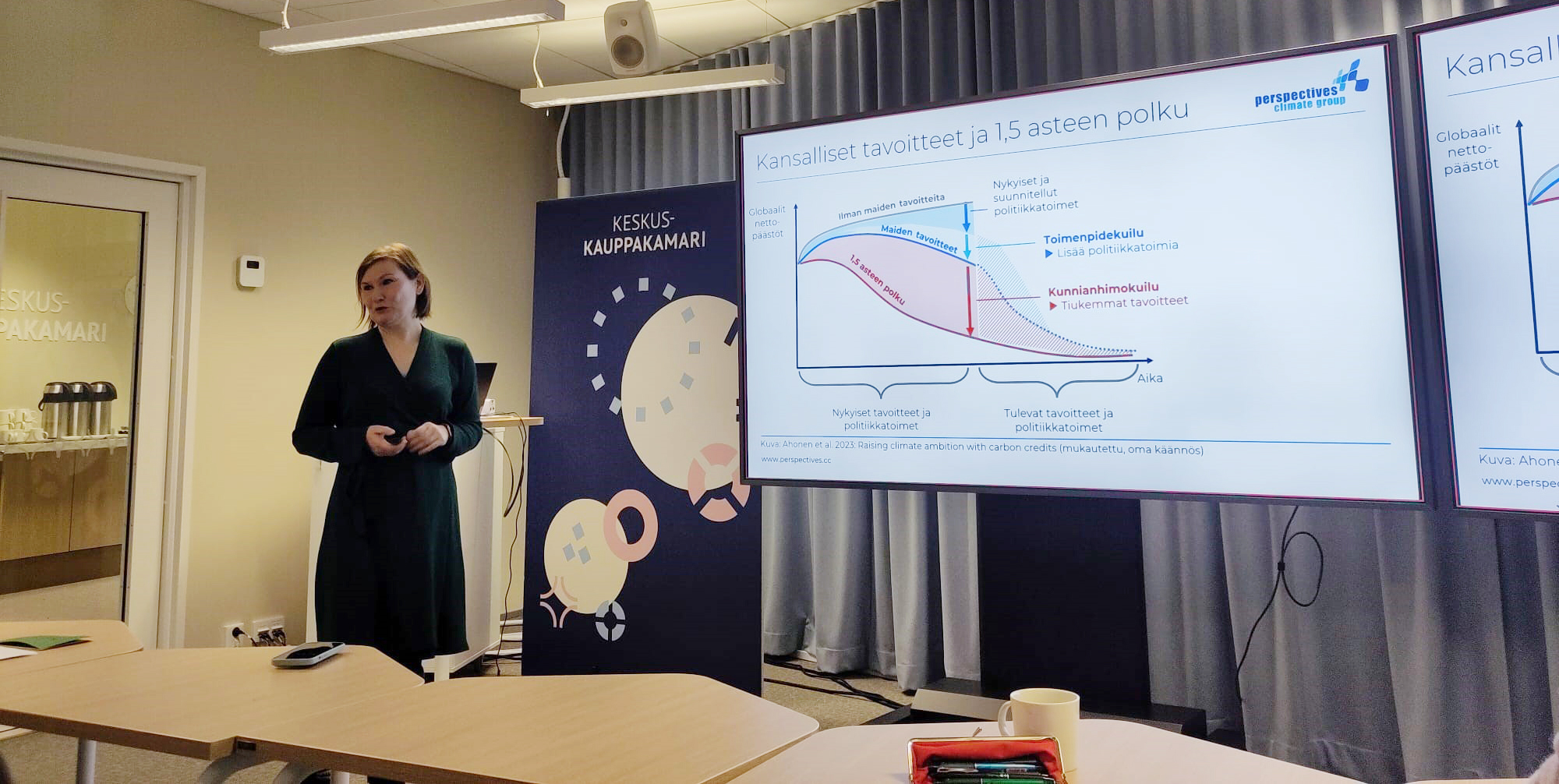
Hanna-Mari Ahonen introduced the Nordic Code.
Photo by Emilie Yliheljo
Photo by Emilie Yliheljo
Part 1: Good practices for the voluntary carbon market and corporate perspectives
Introducing good practices for the voluntary carbon market
The event was opened by Teppo Säkkinen, senior advisor for industrial and climate policy from the Finnish Chamber of Commerce. The Chamber of Commerce aims to promote functioning markets and fair competition, corporate responsibility and cost-effective, market-based climate action. For example, they have a Council of Ethics in Advertising and a Board of Business Practice. The Chamber of Commerce recently launched a programme to support climate action by small- and medium-sized enterprises (SMEs), together with insurance and investment company LähiTapiola. Teppo noted that carbon credits have a role in many companies’ climate work. This event focuses on the demand for high-integrity carbon credits that are generated in Finland or elsewhere in the EU and are suitable for contribution claims and supporting host country targets, in line with good practices.
Hanna-Mari Ahonen, senior consultant at Perspectives Climate Research, introduced good practices for climate claims that are based on carbon credits. She explained how emission reductions and removals that meet relevant minimum criteria can be certified as carbon credits and used for voluntary or compliance purposes. Using carbon credits voluntarily in line with good practices can help to achieve the Paris Agreement’s global 1.5-degree goal by contributing either to national climate targets or to mitigation beyond these targets. Good practices require, inter alia, reducing own value chain emissions in line with science, using only high-integrity carbon credits, reporting transparently and comprehensively and making only credible claims. Currently, carbon credits generated in Finland and the EU can contribute to the Finnish and EU climate targets and serve as a basis for contribution claims.
Companies’ perspectives
Domestic carbon markets have potential, but more regulation and guidance are needed to make them work, said Suvi Järvinen, senior specialist on the climate and environment at LähiTapiola, a Finnish insurance and investment company. LähiTapiola aims for carbon neutrality of its own operations by the end of 2025 and for a net-zero investment portfolio by 2050. While science-based reductions in own emissions are prioritised, LähiTapiola expects some emissions to remain and be addressed by buying carbon credits from the voluntary carbon market. LähiTapiola has an interest in domestic credits, since they are easier to understand and communicate, but also identified the need to avoid double claiming as a key challenge for current domestic markets. Suvi noted that, as awareness is rising, some companies are looking to adjust their climate targets and related communication to enable the use of domestic credits in a way that avoids double claiming. She also highlighted that many of LähiTapiola’s clients, including farmers and forest owners, can have a key role in providing climate solutions, including through the voluntary carbon market. LähiTapiola is motivated to be part of the solution, also by supporting the development of a credible domestic market. Finally, Suvi stressed that trust is a critical precondition for engaging in markets, especially for entities like LähiTapiola that operate in a highly regulated environment. They must comply with requirements and apply good practice, and they cannot take risks that could undermine their credibility. LähiTapiola calls for cooperation to further develop regulation and guidance so that the domestic carbon markets could truly contribute to climate targets and we could agree on common ways to communicate about it.
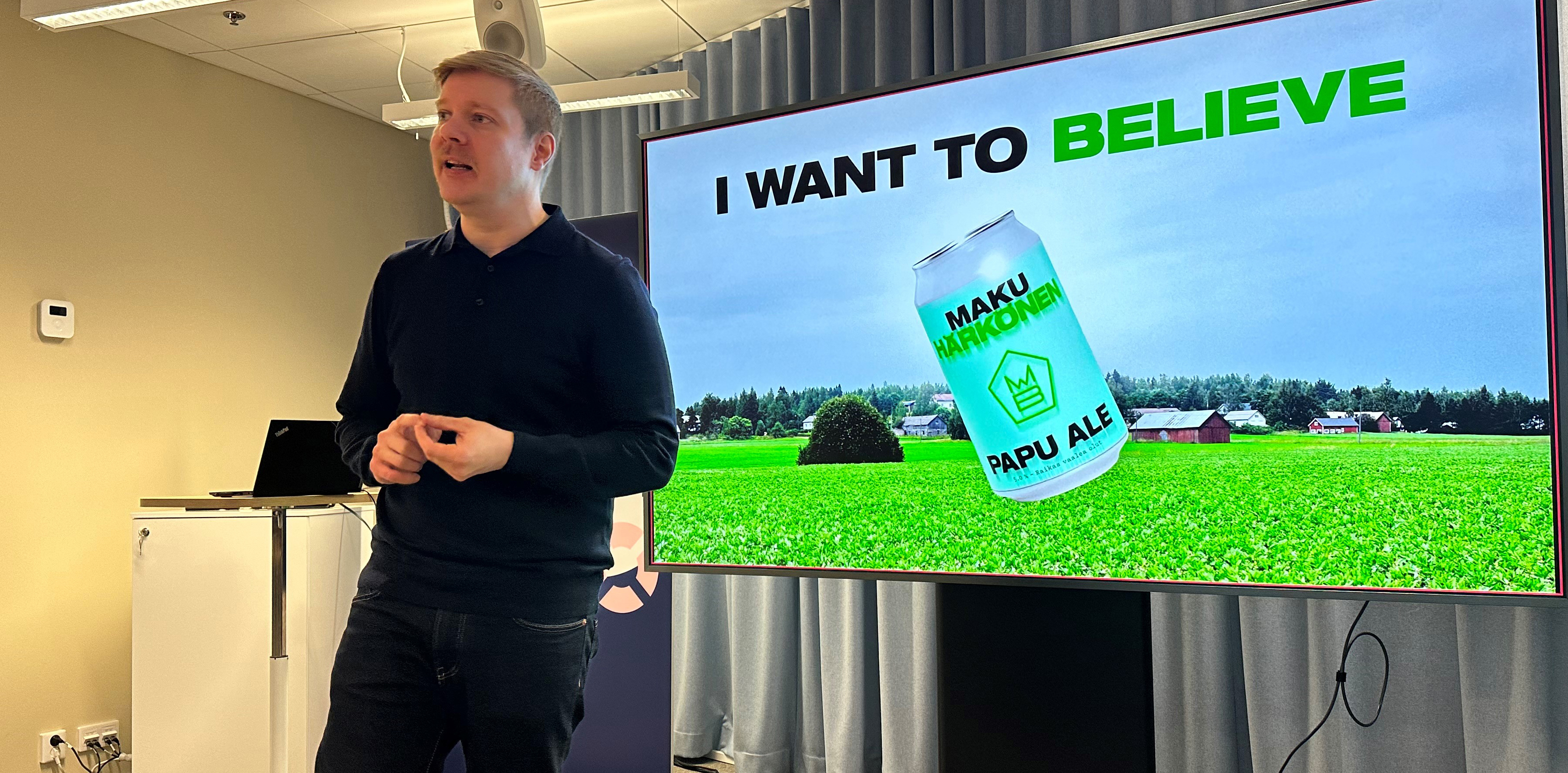
Jussi Tamminen shared Maku Brewing's experiences with the voluntary carbon market.
Photo by Hanna-Mari Ahonen
Photo by Hanna-Mari Ahonen
SMEs struggle to navigate the voluntary carbon market guidance and (mis)information, stressed Jussi Tamminen, founder and CEO of Maku Brewing, a small Finnish craft beer brewery. Since their launch, Maku Brewing has been seeking climate-smart solutions in their operations, such as using emission-free electricity and biogas for transport. They implement a new emission reduction activity each year. In addition, since 2020, Maku Brewing has calculated its value chain emissions and bought an equivalent amount of carbon credits to make their operations carbon neutral. For an SME, the costs relating to calculating carbon footprints and building carbon credits is disproportionally high compared with the potential benefits, which are limited only to marketing and communication. Finance and insurance providers have not taken carbon neutrality into consideration. Besides being the only upside, marketing also comes with risks of negative press and accusations of greenwashing. Jussi noted that guidance is often targeted at larger companies and there is a lot of unhelpful “noise” about the voluntary carbon markets. For an SME, it is very challenging to know which information and advice to trust when engaging in these markets.
Domestic credits are attractive to companies with a domestic client base, said Terhi Naukkarinen, sustainability manager at SOK, which is part of a Finnish network of companies in the retail and service sectors. Ninety per cent of their value chain emissions occur in scope 3, related to groceries and transport fuels. SOK’s current climate targets focus on their own operations, but include also goals that could change consumer behaviour and thus reduce scope 3 emissions, e.g. through increasing the share of plant-based groceries. SOK is also planning to set a net zero target for 2050, including targets for scope 3 emissions. In this context, the calculation of Forest, Land and Agriculture (FLAG) emissions is especially complex. Although the focus is on prioritising value chain emission reductions, carbon credits can also play a role in achieving the climate targets. Given their domestic client base and strong local presence, SOK has a strong interest in domestic credits and is following the market closely.
Voluntary support for domestic climate action is very important for meeting Finland’s climate targets, concluded Karoliina Anttonen, senior ministerial adviser on legal affairs for the Finnish Ministry of the Environment. She stressed that the government of Finland is responsible for all emissions that occur within its boundaries, and further domestic climate action is needed to meet the ambitious national climate target. She called for domestic voluntary carbon markets to contribute to the national target.
Part 2: Workshop on domestic carbon credits and contribution claims
The workshop focused on the demand for domestic carbon credits and related contribution claims. Participants discussed the following questions:
- When and for whom contribution claims can be useful?
- What could these contribution claims look like?
- What influences the demand of domestic carbon credits and related contribution claims?
- Who are the key actors and what are their roles?
- What could be the next steps for promoting domestic carbon credits and claims?
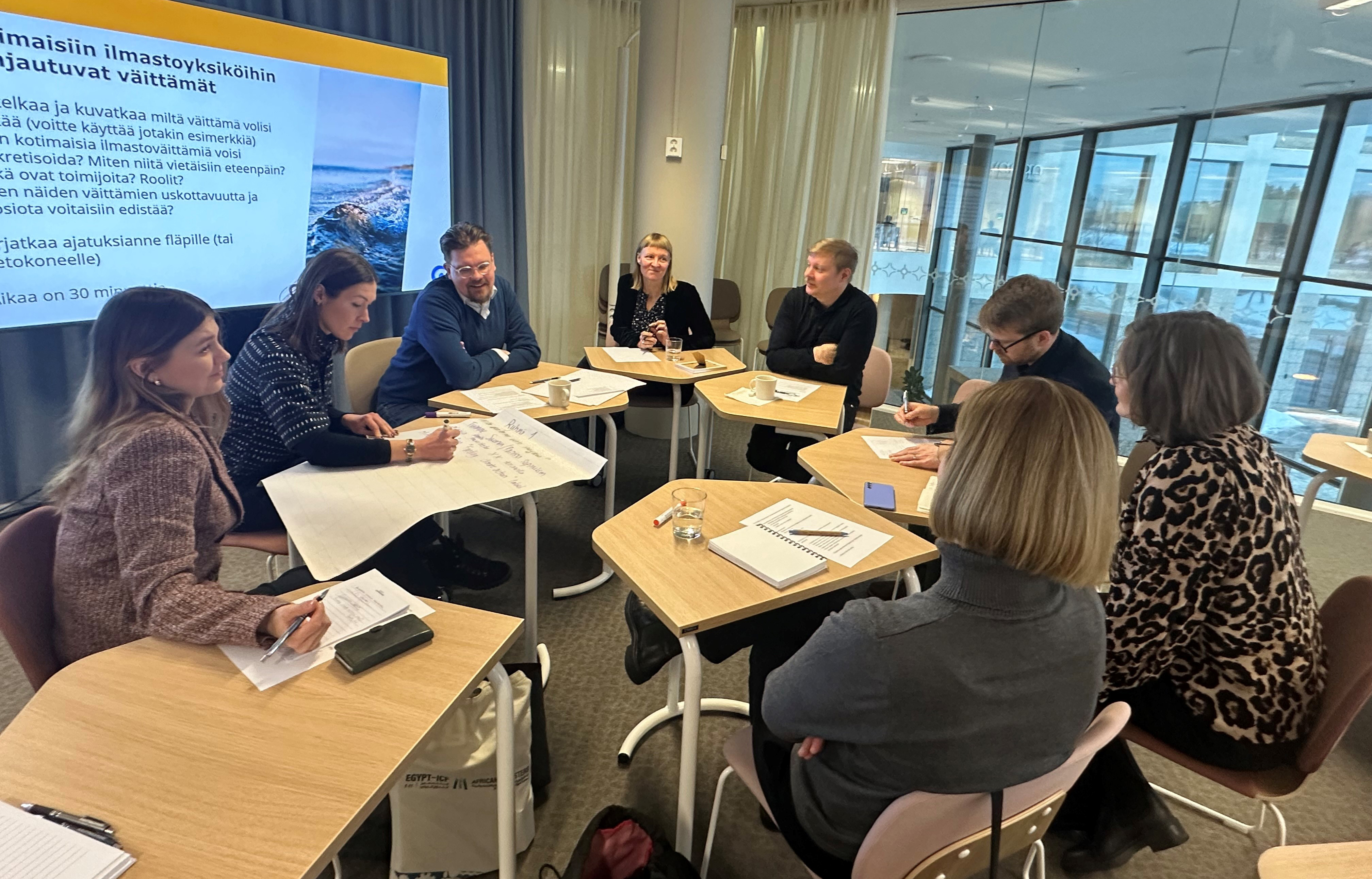
Finnish stakeholders discussed domestic carbon credits.
Photo by Hanna-Mari Ahonen
Photo by Hanna-Mari Ahonen
Regarding domestic carbon credits, participants noted that:
- They would be of interest to companies with a domestic client base
- They could be used for communications targeted at consumers and/or investors
- There is a need to increase companies’ awareness of contribution claims
- Especially SMEs need support and readily available solutions for their climate action
- Buyers expect carbon credits to be of high quality
- The mitigation associated with carbon credits should be reflected in Finland’s national greenhouse gas inventory
- There is currently interest in domestic carbon credits but actual demand is very limited
- Currently marketing is the main driver for demand – domestic carbon credits do not help e.g. in accessing finance
- There is a need for common, science-based rules and reducing “noise”
- The potential for linking domestic carbon credits with ecological compensation should be explored
Regarding contribution claims, participants noted that:
- Claims should be clear, easy to understand, concrete, standardised, trustworthy and verified by an independent third party
- Claims could consist of a label (e.g. Nordic Swan Ecolabel?) and a QR code that provides access to additional information
- The possibility to communicate claims as sponsorship should be explored. In this context, impact and effectiveness would need to be considered.
- There is a need to avoid the proliferation of claims of different types and levels.
- There is scope for national regulation, e.g. a green deal with the government and guidance from the consumer authority
- Self-regulation and cooperation between non-state actors is needed to complement regulation
- The role of the Finnish Chamber of Commerce should be explored, e.g. Council of Ethics in Advertising, Board of Business Practice and support programme for SMEs’ climate work
3.3 Norwegian stakeholder event
On 27 May 2024, Norwegian stakeholders convened in Oslo to explore the voluntary use of carbon credits. This event aimed to foster a comprehensive understanding of best practices at the national, Nordic, and international levels, and facilitate the exchange of insights regarding the challenges and opportunities associated with carbon credit programs. The event was divided into two parts: the first part provided high-level guidance on the utilisation of carbon credits, while the second delved into practical implementation experiences. The event was organised by Carbon Limits.
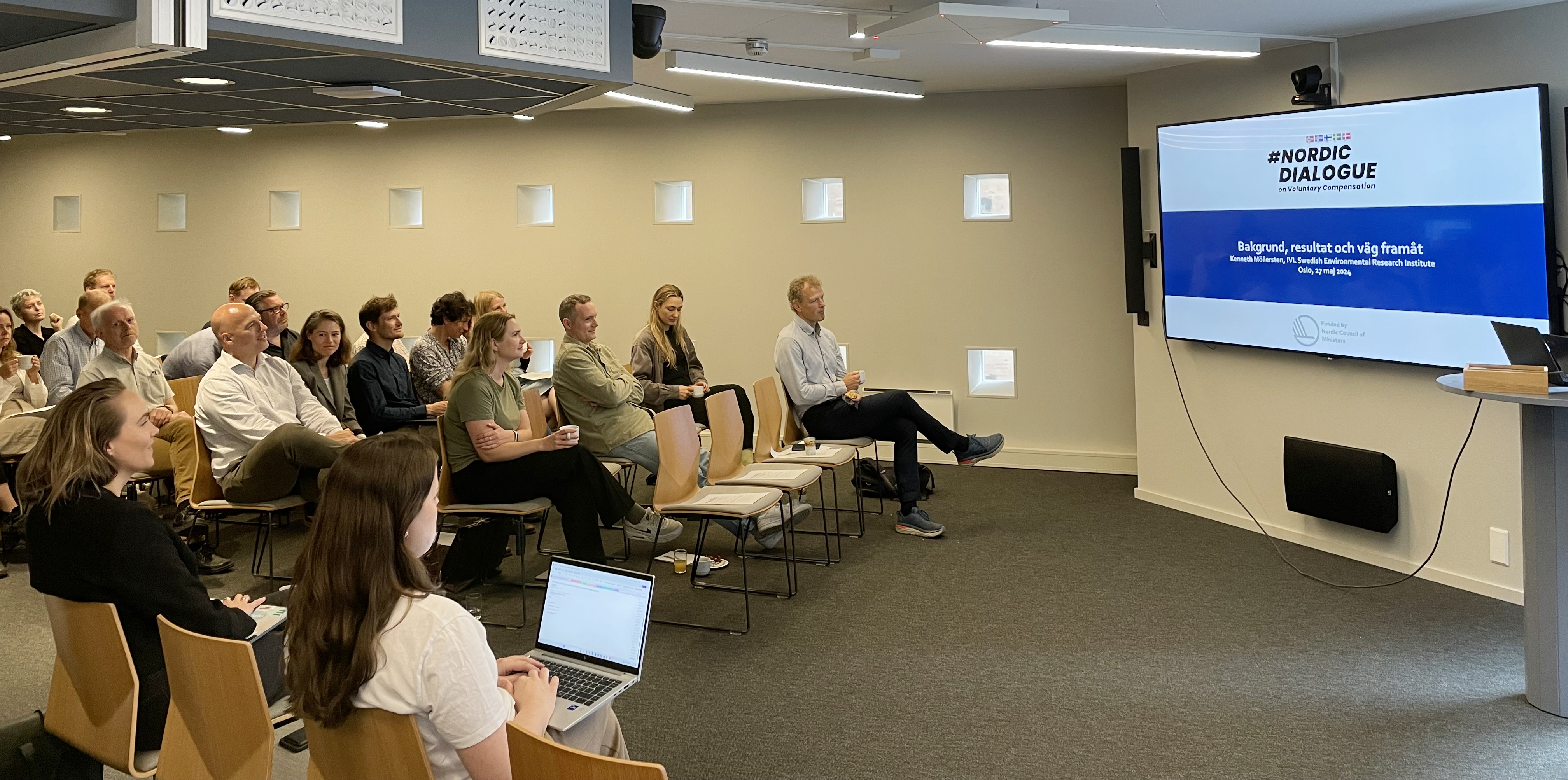
Norwegian stakeholders gathered to discuss the voluntary carbon market.
Photo by Marton Leander Vølstad
Photo by Marton Leander Vølstad
Key takeaways
- Growing interest and evolving market dynamics: Norwegian carbon credit buyers are increasingly interested in purchasing removal credits, highlighting a growing demand within the voluntary carbon market. Despite past challenges, the market is gaining momentum, becoming more serious, and witnessing increased transaction volumes. However, some suppliers are questioning the local relevance of international standards, such as ICVCM.
- Emphasis on quality and trust: There is a rising importance placed on the quality of carbon credits, driven by factors such as the EU regulations and guidance, and the need for high-quality, albeit more expensive, credits. Companies recognise the need to ensure rigorous project assessments to maintain trust in the market, despite the significant administrative burdens this can create.
- Strategic engagement and communication: Effective engagement in the carbon market requires a structured approach: mapping emissions, reducing emissions, and taking responsibility for remaining emissions with high-quality credits. Clear communication on claims is crucial to avoid greenwashing. There is a growing awareness that carbon credits should be used to complement, and not to substitute, reductions in own value chain emissions in line with science.
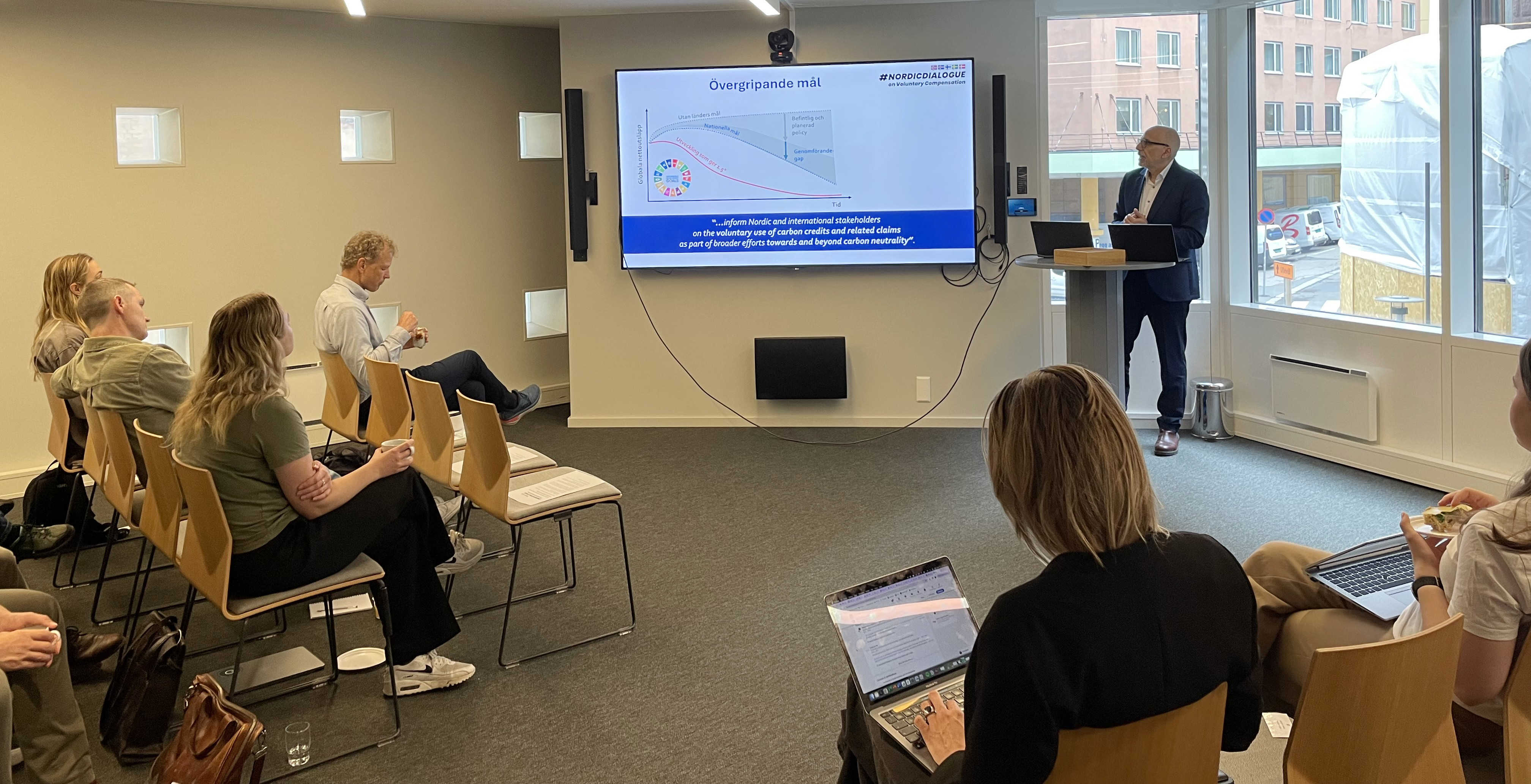
François Sammut (Carbon Limits) introduced the Nordic Code.
Photo by Marton Leander Vølstad
Photo by Marton Leander Vølstad
General insights
- Challenges with market participation: High administrative burdens for smaller companies; larger companies manage through consultants, ratings agencies, accounting providers etc.
- Claims and communication: Companies need incentives to invest in carbon credits and make meaningful climate claims, including the option to use “net zero” in their marketing.
- Terminology debate: Different understandings of terms like “offsetting”, and the need for terminology to reflect the key principles of carbon credit use, such as prioritising science-aligned reductions in own value chain emissions and using carbon credits only to complement, not to substitute, these science-aligned reductions. This would mean using carbon credits only to take responsibility for “unabated” emissions along the way to net zero and “residual” emissions at the net-zero target year and beyond.
- Political and practical distinctions: Debate on differences between avoided emissions and removals have significant political implications.
- Importance of immediate action: Emphasis on acting now despite potential for imperfect solutions, e.g., purchasing credits in high quantities versus only prioritizing quality.
- Role of standards: Debate on the efficacy and objectivity of existing international standards.
Highlights from participants
- Biochar company
- Interest in Removal Credits: Companies like Equinor are showing interest in buying removal credits.
- Environmental NGO
- Market evolution: Companies are keen to engage in the voluntary carbon market, despite past negative experiences.
- Growth in market activity: The market is becoming more serious with increasing volumes and transactions.
- GHG accounting company
- Engagement process: Carbon market engagement should consist of (1) Mapping emissions; (2) Reducing emissions; (3) Compensating residual emissions with high-quality credits.
- Climate fintech company
- EU regulations and credit quality: New questions about the relationship between price and quality of credits.
- Rising importance of quality: Companies are prioritizing higher quality, albeit more expensive, credits.
- Demand for Removal Credits: Growing demand, currently at 20% removals vs. 80% emissions reduction credits.
- Co-benefits and financing: Increasing emphasis on co-benefits and the need for financing in the host country.
- Trust in the market: The market’s foundation is built on trust, with quality directly impacting credit price.
- Project assessment: Companies must individually assess projects, creating a significant administrative burden.
- Independent climate research institute
- Lessons from Clean Development Mechanism: Emphasis on the quality of carbon credits.
- Market formalization: Voluntary carbon market is transitioning into a regulated market.
- Subjectivity of standards: Carbon crediting programmes vary in quality.
- Forestry carbon credit supplier
- Supplier perspective: High access barriers due to the need to choose between multiple carbon crediting programmes.
- ICVCM relevance: Questioning if it is the right approach for Norwegian companies.
- Mitigation hierarchy: Companies should reduce and avoid emissions before compensating remaining emissions with credits.
- Large energy company
- Buyer perspective: High administrative barriers to accessing carbon credit rating agencies like Sylvera and BeZero.
- Case-by-case evaluation: Quality evaluation depends on individual projects.
- Reliance on carbon crediting programmes: Crediting programmes and ratings agencies are essential.
- Article 6 expert
- Purpose of credits: Depends on usage and claims made by buyers.
- Focus on additionality: Climate finance should support projects that would not be financed otherwise, especially in developing countries.
3.4 Swedish stakeholder event
On 12 June 2024, Swedish stakeholders gathered online to discuss and build capacity concerning the voluntary use of carbon credits in the context of a rapidly changing policy landscape. Around 70 stakeholders participated in the event. Participants were invited to listen to a number of presentations, participate in a Q&A session, and respond to a questionnaire. The event recording is available on the Nordic Dialogue website. The event was organised by IVL Swedish Environmental Research Institute.
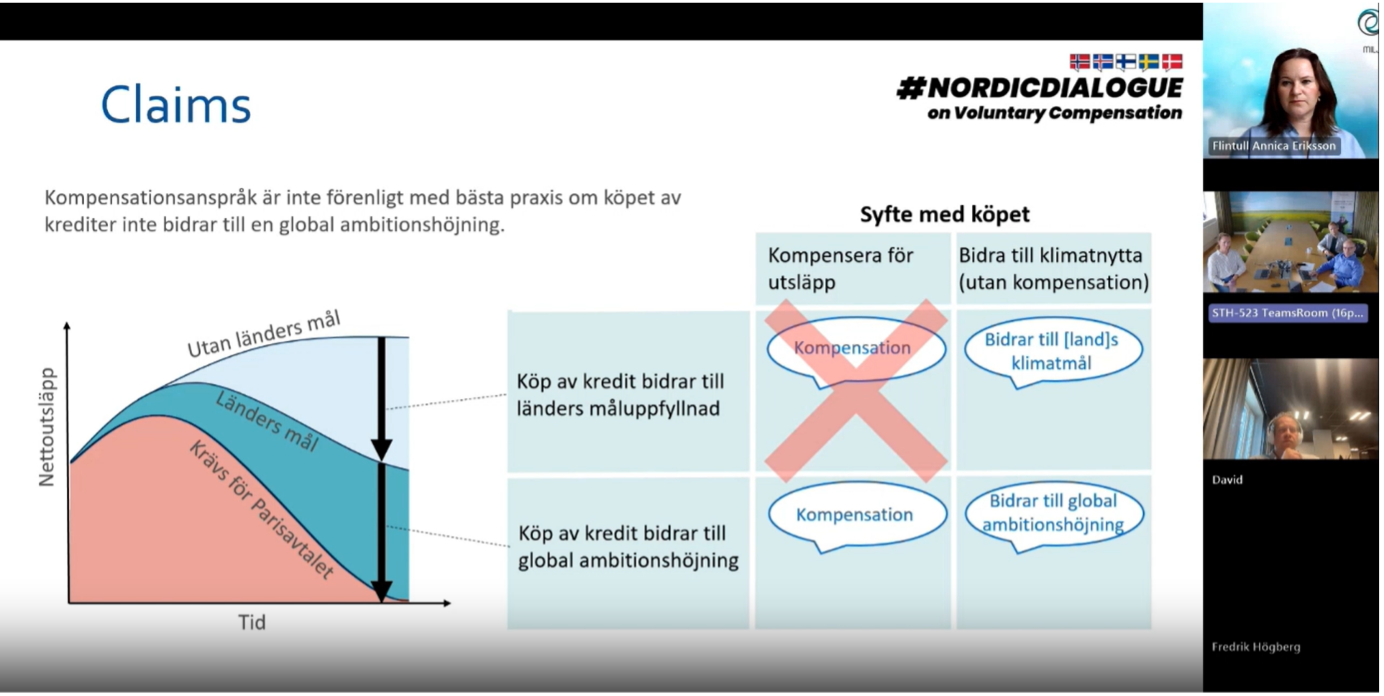
Kenneth Möllersten (IVL Swedish Environmental Research Institute) introduced the Nordic Code.
Key takeaways
- Many companies and other types of organisations are taking action to manage and gradually reduce their climate impact. Many are considering the voluntary use of carbon credits in addition to ambitious in-value chain mitigation. However, international guidelines and standards as well as EU regulation are evolving rapidly and are challenging for many stakeholders to understand.
- Regulation is gradually reducing options for legally making offsetting claims. So-called contribution claims are emerging as an alternative to offsetting, but the concept is relatively new and untested. Many stakeholders show an interest in contribution claims and want to learn more.
- Regulatory uncertainty surrounding offsetting claims will prevail to some degree until all relevant EU directives have been adopted and then transposed into national law in Member States and empirically tested.
- Emerging guidance on beyond value chain mitigation provides stakeholders with best-practice approaches grounded in climate science and policy that enable organisations to take responsibility for the emissions still occurring, while implementing robust action towards reducing the organisation’s carbon footprint.
- There is a significant need for dedicated capacity-building to raise stakeholders’ awareness and capacity to make informed decisions. Many participants felt that the event had been useful and requested more of the same as the policy landscape evolves.
Highlights from the presentations and Q&A session
- The Nordic Code of Best Practice for the Voluntary Use of Carbon Credits was introduced to the participants. During 2021 to 2022, the Nordic Dialogue on Voluntary Compensation team and an extensive working group of Nordic stakeholders worked together to foster a common understanding of best practices for the voluntary use of carbon credits and co-create the Nordic Code, which can be used as a foundation for making credible offsetting or contribution claims. Continued efforts to keep the inclusive process alive were encouraged by participants.
- The consumer protection authorities of the five Nordic countries have made a joint “Nordic statement on climate compensation claims in marketing”
. Consumer protection authorities advise businesses to carefully review their offsetting claims. They highlight that many companies may struggle to substantiate the accuracy of these claims due to issues like the lack of permanence, the risk of double counting, and lack of additionality. The statement also emphasises that Nordic consumer protection authorities have the authority to initiate enforcement actions to ensure that offsetting claims are compliant with Directive 2005/29/EC on unfair commercial practices, as transposed in the Nordic countries. - Upcoming EU legislation, aimed at protecting consumers from so-called greenwashing, introduces a ban on claims such as “climate neutral” for goods and services when offsetting of products’ carbon footprint is involved. Further EU legislation is being developed to regulate climate-related claims, including the voluntary use of carbon credits at the organizational level. This forthcoming legislation will bring significant changes to how companies may communicate and operate in this field. Several questions have been raised about the implications of this new legislation for companies and other stakeholders in various specific contexts.
- Stakeholders are adapting to the changing regulatory context and revising the formulation of climate-related targets, mitigation strategies and how to frame and communicate climate-related claims. This was exemplified by an overview of ongoing work in the Malmö region LFM30 initiative, which represents a large group of stakeholders in the building, construction, and real estate sectors.
- Companies can continue to support climate projects and increase their ambitions without making claims of climate neutrality. Practical guidance for so-called beyond value chain mitigation (BVCM) has recently been published. The guidance covers strategies for mobilising finance and supporting climate action beyond the value chain or organisational boundary, including through the voluntary use of carbon credits, and how to transparently and concretely communicate regarding climate action. Positive examples of such practices were shared.
- Several participants showed an interest in learning more about BVCM and to participate in open forums where stakeholders can continue to meet, discuss and build capacity.
3.5 Nordic workshop on green claims
On 4 September 2024, Nordic regulators and other invitees gathered online to discuss credible climate claims based on carbon credits. The event aimed to raise awareness of the current status of green claims guidance and EU legislation, identify and exchange views on key open issues, and discuss ways to address them. The event had three parts: (1) an introduction on the current status of green claims guidance and regulation; (2) a workshop session on identifying and exchanging views about key open issues relating to claims; and (3) a workshop session identifying options for addressing these issues. The introductory presentation is available in the Nordic Dialogue website. The workshop sessions included posting thoughts on a virtual whiteboard and discussing them in the group. In total, 22 participants attended the workshop, including representatives from all Nordic countries as well as two other EU countries, from consumer agencies, ministries, chambers of commerce and the private sector, as well as ecolabelling and standard-setting organisations. The event was organised jointly by Perspectives Climate Research, Tyrsky Consulting and IVL Swedish Environmental Research Institute.
Status of green claims guidance and EU regulation
Hanna-Mari Ahonen, senior consultant at Perspectives Climate Research, opened the event with an overview of the Nordic project, key terms and the current status of green claims guidance and EU regulation. She noted that, as an alternative to the traditional offset claims (e.g., carbon neutrality, net zero), contribution claims are now emerging.
Offset claims convey that the claimant has counterbalanced its own value chain emissions with carbon credits while contribution claims are about the claimant contributing to global or national mitigation efforts, for example through carbon credits, without implying that their own emissions are counterbalanced as a result.
The key difference between carbon neutrality and net zero claims is that an organisation should claim net zero only after it has reached its long-term emission reduction goal, by 2050 at the latest, by reducing its value chain emissions in line with the global 1.5°C target and offset any remaining (“residual”) emissions with permanent removals. Carbon neutrality claims can be done also on the way to net zero and potentially also by organisations that are not reducing their own value chain emissions consistently with the global 1.5°C target.
Hanna-Mari introduced three key questions related to claims based on carbon credits:
- What claims can be made, including types (offset claims, contribution claims, claims about future performance) and levels (product level, organisational level)?
- Who can make claims: all organisations or only certain organisations, such as those that are on the pathway to net zero?
- How should these claims be substantiated, in terms of e.g. disclosing key information, demonstrating carbon credit quality, avoiding double counting?
She provided a summary of what the Nordic Code of Best Practice and current and proposed EU legislation say about these issues.
What claims can be made?
The EU has agreed to ban product-level offset claims based on carbon credits and is in the process of elaborating further requirements for the substantiation and communication of green claims, under the proposed Green Claims Directive. The Parliament and Council have adopted positions that would allow organisations to make offset claims (at organisation level only), contribution claims and claims about future performance based on carbon credits, subject to specific requirements.
Who can make claims?
The Parliament’s and Council’s positions differ somewhat. The Parliament would limit offset claims to addressing “residual” emissions (to be defined by the Commission). Depending on how these “residual emissions” are defined, this could mean that only organisations that have achieved their long-term net zero targets could make offset claims, and only from the target year onwards (in 2050 at the latest). The Council proposes to limit offset claims to organisations that have a net zero target and are making progress towards it, in line with the EU Sustainability Reporting Standards (ESRS). This is consistent with the Nordic Code of Best Practice, which requires organisations to reduce their own value chain emissions in line with a 1.5°C pathway.
How should claims be substantiated?
The Parliament and Council have similar positions on information that needs to be disclosed and somewhat different positions on the credits that can be used. Organisations need to, inter alia, report their value chain emissions separately from carbon credits, and specify the type of carbon credit (emission reduction vs removal). For offset claims and claims about future performance, the Parliament would allow only credits certified under the forthcoming EU Carbon Removals and Carbon Farming (CRCF) certification framework or an equivalent scheme approved by the Commission. The Council proposes organisations to report how they ensure the high integrity of the carbon credits used, such as through “recognised quality standards” as defined in the ESRS. While the Nordic Code requires avoiding double claiming between offset claims and national targets, neither the Parliament nor the Council explicitly require it. The Parliament’s position to use CRCF credits could even lead to double claiming between offset claims and the EU climate targets. The Council proposes that the Commission adopts more detailed rules for offset and contribution claims by the end of 2027, taking into account international standards and Article 6 of the Paris Agreement.
Workshop sessions on key open issues and options to address them
During the first workshop session, workshop participants identified key open issues, including issues that were unclear, problematic, or in need of further development. In the second session, they explored options for addressing the identified issues. Participants considered possible actions, how to implement them, who to engage and how. Key issues identified included unclear definitions and requirements, inconsistent carbon credit quality, double claiming, insufficient incentives for contribution claims, and the international context.
Lack of clarity
The lack of clarity, particularly regarding key definitions, was identified as a major barrier to making credible claims. Many participants called for addressing the lack of clear and unambiguous definitions for offset and contribution claims, including clearly distinguishing between the two and specifying detailed requirements. Concerns were raised that consumers may not understand company-level climate claims and their implications for deciding which products to buy. The lack of clarity also hinders the mobilisation of finance via the voluntary carbon market for additional mitigation, including for removals to be certified under the CRCF. It was noted that the 2027 deadline for detailed rules would mean three more years of market uncertainty.
The need for more and detailed rules for certain claims was also challenged, with some arguing that the existing general principles and current legal framework already provide a sufficient legal basis for enforcement actions by consumer protection authorities. It was noted that many companies are not well aware of even the existing rules, including the ban on product-level offset claims based on carbon credits. The shift from product-level to organisation-level claims was seen as blurring the boundaries between claims and corporate sustainability reporting. Although there were some reasons identified for involving business-to-business companies in the green claims discussions, it was also pointed out that the EU green claims legislation targets consumers, not corporate sustainability reporting or business-to-business communication.
Many participants supported addressing these issues in the near term by developing interim guidance for claims. This guidance could include clear definitions and require companies to disclose the type, origin, quality, and impact of carbon credits. Participants also supported launching public awareness campaigns to educate consumers about the differences between various types of carbon credits and claims. Aligning key terms across EU legislation, such as the ESRS, was suggested.
Nordic consumer authorities, already cooperating closely, could issue joint statements, similar to their previous statement on claims. However, challenges could arise if the Green Claims Directive is implemented into national law, particularly if claims are assessed by private accredited entities. To address this, industry and civil society could organise joint workshops with consumer authorities. While positive examples and case studies could be valuable, their context-specific nature may make them difficult to formulate. Frontrunner companies could lead by showcasing concrete examples. In the long term, creating a unified EU standard for carbon credit certification and establishing an independent EU-wide verification body for validating claims were proposed. Additionally, investing in technology and research to enhance monitoring and verification processes represents a significant long-term opportunity
The close cooperation of Nordic consumer authorities was recognised and its continuation seen as important. Nordic consumer authorities could make joint statements, similar to their statement on climate compensation claims in marketing. It was, however, noted that implementation of the Green Claims Directive into national law could pose challenges for such cooperation, in case claims are assessed by (private) accredited entities. Other cooperation opportunities included joint workshops between consumer authorities, industry and civil society. While positive examples and case studies were identified as helpful, it was also noted that the context-specific nature of claims can make it difficult to formulate positive examples. Frontrunner companies could lead by showcasing concrete examples. Long-term proposals included creating a unified EU standard for carbon credit certification and establishing an independent EU-wide verification body for validating claims. Investment in technology and research to improve monitoring and verification processes was also identified as a longer-term opportunity.
Inconsistent carbon credit quality and double claiming
Participants identified inconsistent carbon credit quality as a major issue that needs to be addressed. They highlighted trust in carbon credit quality as essential for making credible claims. The lack of standardisation across countries and sectors in the carbon credit certification processes was noted as a cause of varying levels of quality and trustworthiness.
Participants suggested that the EU should lead by example in addressing this issue. They proposed developing clear EU guidance for defining and assessing carbon credit quality. Key quality considerations should include additionality, permanence, timeliness, and leakage, and they could contribute to a clearer definition of “excellent environmental performance”. Furthermore, they recommended incorporating the planetary boundaries model and properly attributing mitigation outcomes to financial sources. Participants also pointed out the role of researchers and non-governmental organisations in identifying effective mitigation strategies and sustainable development investments.
Participants presented differing opinions on whether to avoid or allow double claiming. One opinion was that avoiding double claiming is essential to maintaining the credibility and efficiency of the market, while another opinion was that allowing double claiming was could facilitate the allocation of capital to green investments. It was noted that double claiming is a risk specific to offset claims and it can be mitigated by using carbon credits authorised under Article 6.2 of the Paris Agreement. Alternatively, when using unauthorised credits, double claiming can be avoided by making contribution claims.
Lack of incentives for contribution claims
Some participants observed that, due to historical reasons, many companies still prefer offset claims and do not see a compelling business case for making contribution claims. They suggested that if EU regulations mandated the avoidance of double claiming between offset claims and national targets, it could drive demand for contribution claims – particularly given the current limited supply of authorised.
Participants emphasised the need to strengthen the business case and incentives for contribution claims, such as by creating an alternative framework for contributions. Think tanks and research organizations could play a role in this effort, for example by recognising and showcasing exemplary cases of beyond-value-chain mitigation, helping to increase interest in contribution claims.
International context
Several participants highlighted the importance of considering the international context due to the global nature of carbon markets. They called for clarity on how companies' existing net-zero and other pledges under international initiatives, such as those from the ISO and the SBTi, interact with emerging EU green claims rules. More clarity is also needed regarding the role of carbon credits in achieving Scope 3 targets. Additionally, the issue of making claims outside the EU using EU-based carbon credits was raised.
Participants identified the SBTi, ISO, the European Committee for Standardization (CEN), and the European Committee for Electrotechnical Standardization (CENELEC) as key players in the international context. The SBTi was viewed as an influential among companies, informing corporate carbon credit use as much as EU legislation. The SBTi’s work on planetary boundaries, which is referenced in the ESRS, was identified as a notable example. If the EU were to restrict offset claims to credits certified by the EU-based CRCF, some argued this could be perceived as a protectionist move to keep EU finance from supporting mitigation efforts outside the region.